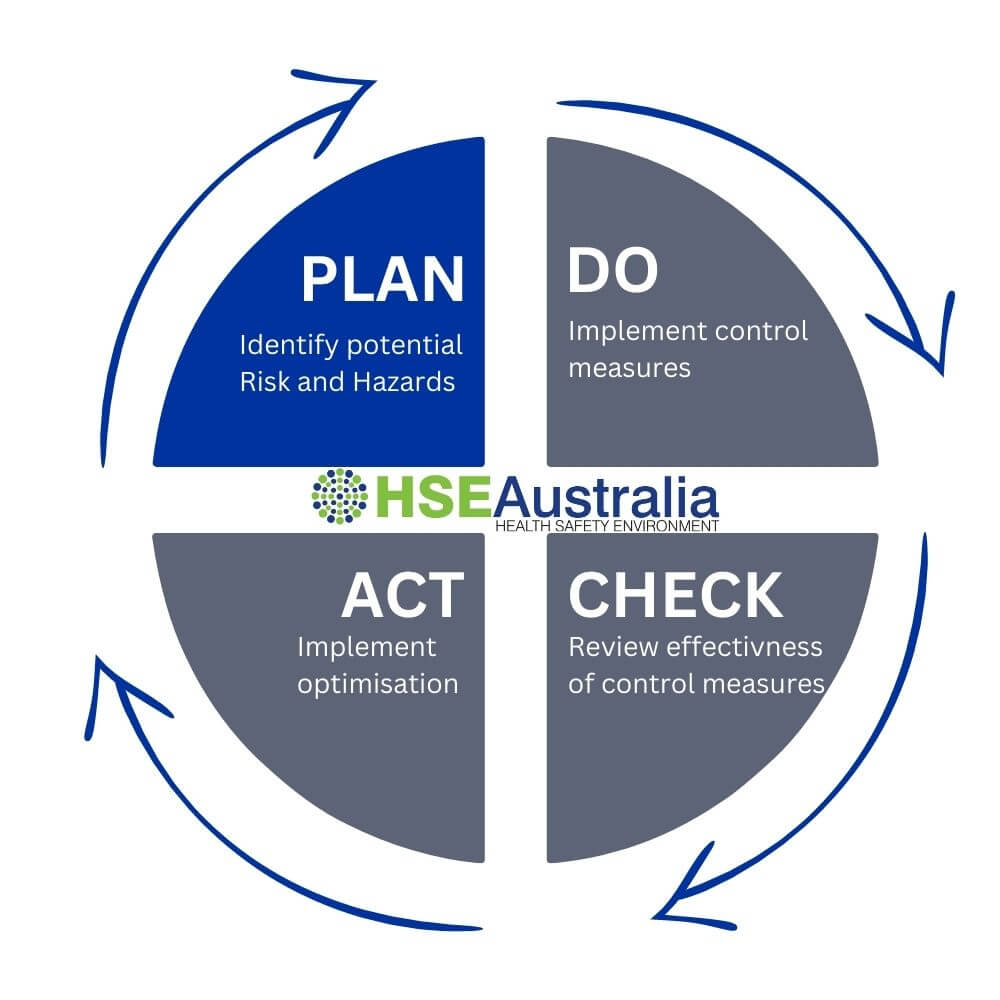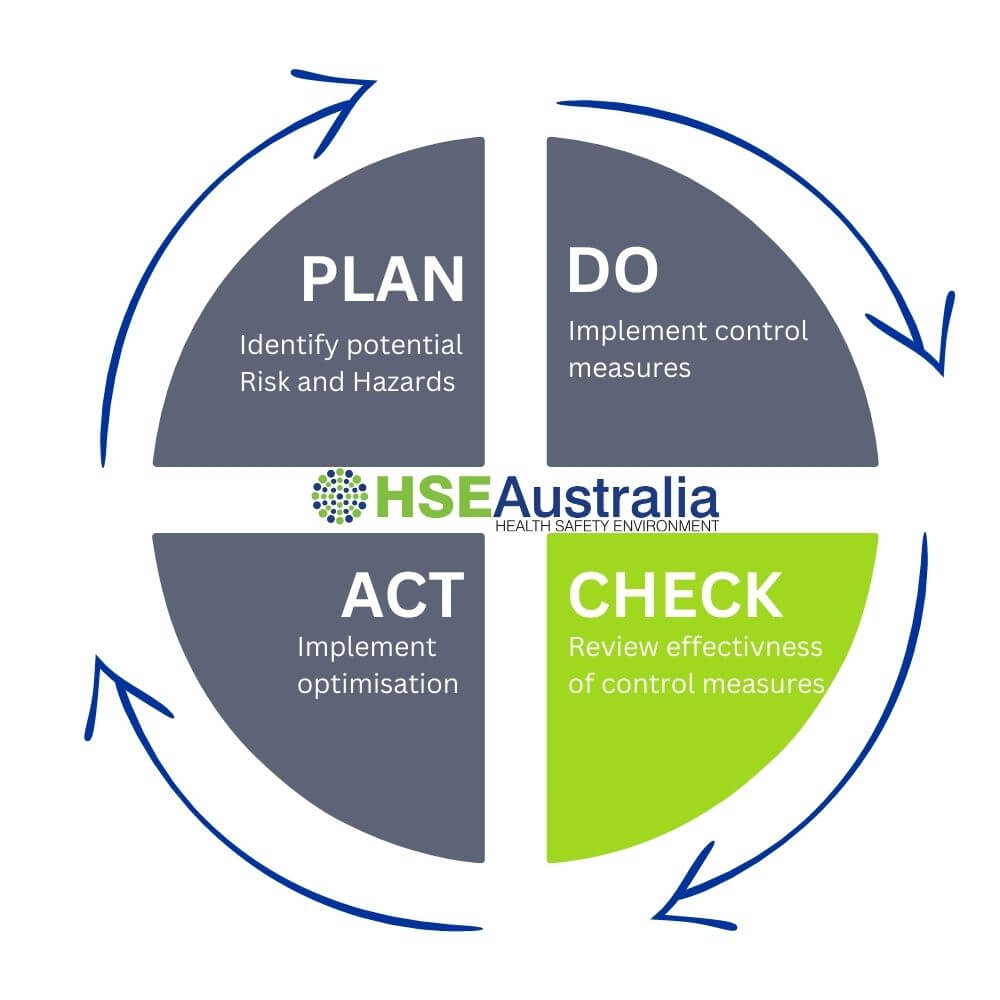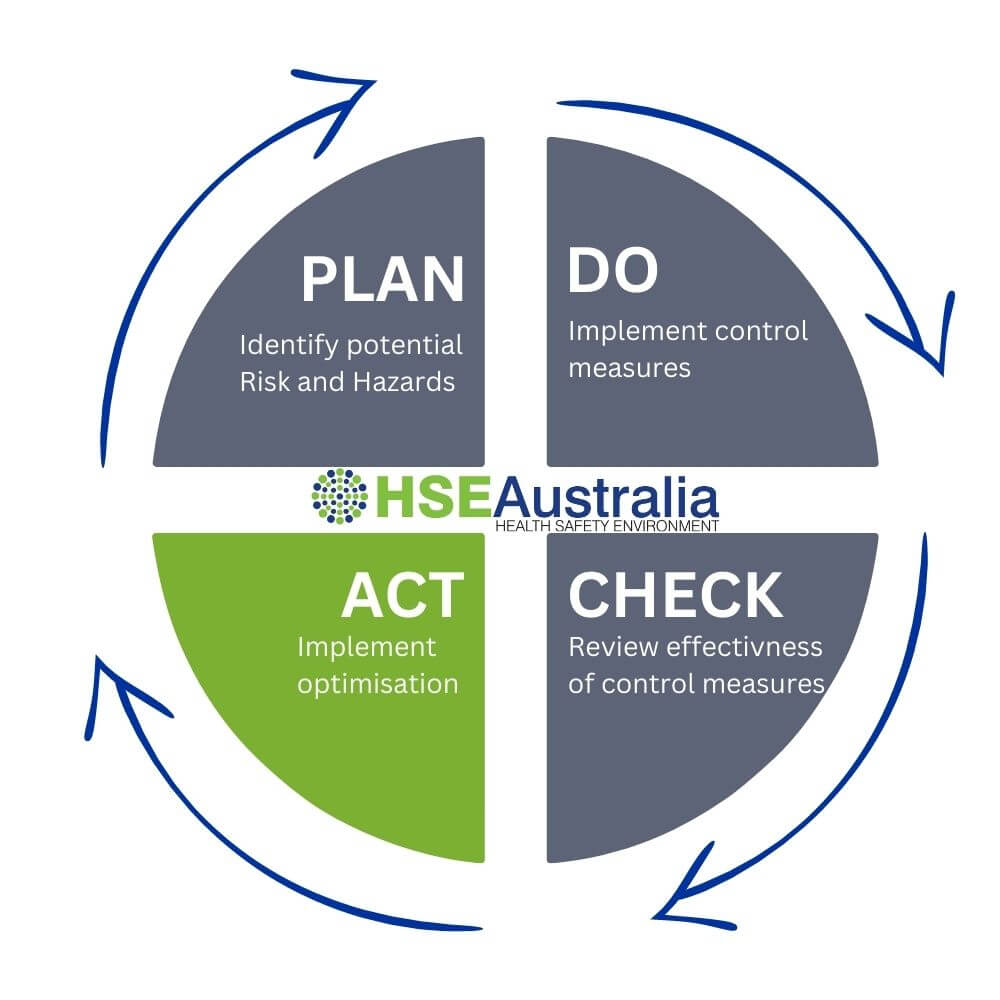Mastering Safety
Enhancing WHS Management with the PDCA Approach
WHS Management
Work Health and Safety Management (WHS) is not a one-off task, it is not limited to the policies and procedures of a company, and it is not something that can simply be handed over to an external partner.
WHS management is a company-wide approach, an ongoing responsibility; and its continual actions and improvements are the duty of all people in a workplace.
External specialists can help to identify risks, hazards, or gaps in compliance. They can provide expertise and guidance. However, Work Health & Safety Management needs to be an integral part of an organisations systems and structures.
Work Health & Safety Responsibilities
Under the Work Health and Safety (WHS) Regulations, the Person Conducting a Business or Undertaking (PCBU) is the one who bears the legal responsibility.
The PCBU – which could be the owner, manager, or the responsible person in an organisation – is mandated to ensure a safe work environment for all.
This responsibility extends to creating and sustaining safe work systems, such as proper handling, storage, and transport of potentially hazardous items. It also includes ensuring psychological hazards and risks are addressed and eliminated.
A PCBU is also responsible for providing any necessary information, training, instruction, and supervision to workers to ensure their health and safety. Monitoring workers health and workplace conditions is also a fundamental part of this role to prevent work-related illness and injury.
In addition to creating and ensuring a safe work environment, PCBUs, under the WHS Regulations, are obliged to manage risks by identifying potential hazards, assessing the risks, implementing control measures, and subsequently reviewing their effectiveness.
The organisation must consult with workers and other duty holders, as well as fulfill their reporting obligations, such as detailing serious injuries, illnesses, fatalities, and other safety incidents including near misses or close calls.
Given the extensive responsibilities of a PCBU, in regard to safety, non-compliance to the WHS Regulations can attract severe penalties, including fines and even imprisonment.

What are the different types of vibration?
A straightforward process that will have a significant impact on WHS Management is the PDCA approach, or the “Plan, Do, Check, Act” approach.
It is a reliable and effective method for managing and continually improving Work Health and Safety (WHS) in your organisation.
The Plan, Do, Check, Act approach involves developing a safety plan (Plan), implementing the plan (Do), evaluating its effectiveness (Check), and making necessary adjustments for continuous improvement (Act).
It is important to note that a review or audit of your workplace or work environment must be conducted before implementing a PCDA process.
To follow the PCDA approach you need to:
Plan in detail what needs to be done (the work or task).
Implement the necessary changes from your plan, as the task dictates.
Constantly review the implemented control measures
Act if your measures are not effective.
This will support you with:
- Constantly identifying areas that need improvement.
- Implement measures quickly to ensure your workers and others are safe.
- Assuring a constant review of the effectiveness if your arrangements.

Plan

Describe in detail how your organisation is aiming to manage health and safety, and how it plans to implement safety measures in practice. This plan may become part of your organisations WHS policy.
It must be noted, that a WHS Compliance Audit might have to be completed before a plan can be developed.
To be able to plan successfully, focus on:
- The organisations current situation, the future state of WHS in your organisation, (GAP Analysis) including compliance concerns, and what needs to be done to obtain compliance and the organisations goals.
- Setting priorities around changes and the improvements necessary
- Determining and documenting responsibilities and duties of people that support the management if WHS in your organisation.
- Communication and feedback before and during the implementation.
- Emergency procedures, in case of accidents such as serious injuries, fire, flood or chemical spills.
Do

The next step in your WHS process is to implement your plan into the organisation.
Completing the following tasks with help you to manage Work Health and Safety effectively:
- Assess your organisation or your workplace risks – prioritise, assess, and control risks
- Publish and communicate information and conduct training – ensure your workers have enough information and guidance to do their job safely
- Focus on your workers wellbeing, also, e.g., by providing or renovating workplace facilities such as toilets, showers, washbasins, or break areas
- Protect vulnerable workers – prioritise workers who are vulnerable or have specific risks, including those with disabilities or young and inexperienced workers.
- Promote and empower your people to report their safety concerns, accidents, near-misses or close-calls and injuries or cases of workplace diseases.
- Implement and train workers to provide first aid and have necessary first aid resources and equipment readily available.
- Prominently display and present WHS information (e.g., regulations, policies, posters, etc.) at your workplace
Check

Review and measure the effectiveness of the controls implemented.
Check that processes and procedures are working properly and that potential risk of exposure to hazards are controlled and minimised.
Effective monitoring will help you identify problems, understand what caused them, and ensure the appropriate improvements can be made, to reduce the likelihood of incidents occurring in your workplace.
This process includes:
- Conducting frequent, scheduled checks of the workplace and tasks to identify new risks and identify workers that might need more guidance.
- Executing maintenance.
- Conducting Workforce Health Assessment of workers working with hazardous substances.
- Delivering refresher training and conducting competency checks.
Incident investigation and researching the reasons for absences from work is part of the check phase of the PDCA process.
Investigating incidents
To understand causes and patterns of incidents, an organisation must aim to investigate all incidents, accidents, and near misses.
This will help to:
- identify where control measures failed
- identify opportunities for improvements
- improve risk & hazard control measures for the future
- amend WHS strategies and plans
Absences from work
As part of your WHS process it is recommended to follow up absences from work. Absenteeism might be caused by a work-related illness the organisation may not be aware of.
Act

The “Act” phase of the “PDCA” approach includes implementing necessary changes based on the results from the “Check” phase.
This can include taking corrective and preventive actions to address any identified deficiencies during the checking or monitoring phase.
It could also involve revising the WHS policy, procedures, objectives, or processes to better manage risks and improve safety performance. The goal of this phase is to drive continuous improvement in the WHS management system.
After adjustments are made during the “Act” phase, the PDCA cycle begins again with the “Plan” phase, ensuring ongoing improvement in the organization’s WHS performance.
In conclusion, the “PDCA” or Plan, Do, Check, Act approach provides a dynamic framework for managing and continuously improving Work Health and Safety (WHS) in your organisation.
This ongoing system allows organisations to proactively address hazards, assess risks, implement safety measures, and adapt based on their effectiveness.
This will lead to a safer, more productive working environment.
Implementing the PDCA approach means promoting a culture of safety, where every action is geared towards sustainable improvement. In the realm of WHS, constant and continuous improvement is not just an aspiration—it is a necessity.
Contact HSE Australia for more details
Please get in touch if you have any questions or concerns regarding Work Health and Safety at your workplace. Please call 1300-SAFETY
If you have any concerns regarding Vibration at your workplace, please contact us.
HSE Australia’s team of Occupational Hygiene Specialists is available 24/7 and Australia-wide.

